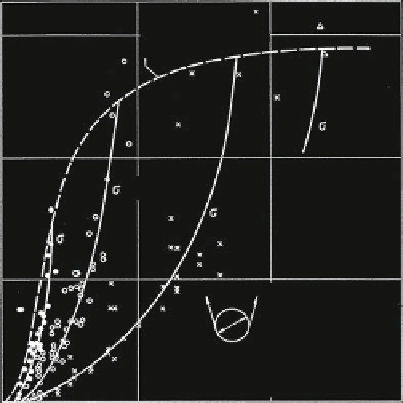Civil Engineering Reference
In-Depth Information
However, for a variety of reasons, the progressive elongation of the rope often
cannot be detected in practice.
3.2.9 Number of Wire Breaks
The endurance of wire ropes running over sheaves is always limited. Fluctuating
stresses and increasing wear lead to an increasing number of wire breaks. The
number of wire breaks referring to a pre-defined length, the rope reference length
is the most important discard criteria for wire ropes.
3.2.9.1 Growth of the Number of Wire Breaks
The first wire break occurs on a wire rope running over sheaves after several
bending cycles. After the first break, the higher the tensile stress r
z
and the smaller
the diameter ratio D/d is, the faster further wire breaks occur. An early diagram,
Fig.
3.68
shows the numbers of wire breaks observed in bending fatigue tests and
their mean curves.
In single bending cycle fatigue tests with relatively small bending lengths, the
increase in the number of wire breaks is not uniform. The observed number of
outside wire breaks of a Filler rope is shown in Fig.
3.69
. Other examples of the
increase in outer wire breaks can be found for different tensile stresses and
diameter ratios D/d, in Woernle (
1929
,
1931
), Rossetti and Thaon (
1977
),
120
break of the
first strand
z
=
200 N/mm
2
80
z
= 350
z
= 250
z
=
450
40
S
Seale 6 19
−
IWRC
ordinary lay
d = 16 mm
D/d = 35
r = 6.5 mm
steel HB = 600
D
0
0,5
−
10
5
10
5
1,5
−
10
5
number of bending cycles N


Search WWH ::

Custom Search